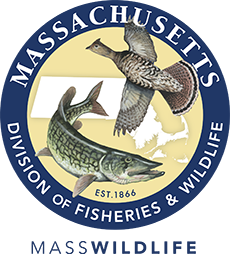- Division of Fisheries and Wildlife
Media Contact
Media Contact, MassWildlife
MassWildlife is collaborating with the U.S. Fish and Wildlife Service (USFWS), numerous state wildlife agencies, Worcester Polytechnic Institute, and other conservation partners on a range-wide project examining the annual movements and survival of the wood thrush. Wood thrushes (Hylocichla mustelina) are Neotropical migrant forest nesting songbirds that have been experiencing long-term population declines. It is estimated that over 50% of the population has been lost since 1970. They are listed as a Species of Greatest Conservation Need in MassWildlife’s State Wildlife Action Plan and a Species At-Risk by the USFWS.
MassWildlife and partners will collect data on the timing of wood thrush yearly cycles, movement patterns, and survival rates across their breeding grounds including Massachusetts, along migration paths, and in areas of Mexico and Central America where they overwinter. Geographic data will be recorded to track migratory pathways and areas along the migration route with large concentrations of birds. This information will help answer long-standing questions about whether wood thrush populations are impacted most by conditions where they breed or in areas where they overwinter. The study also will identify important stop-over areas that support birds along their migrations. Study results will expand biologists’ understanding of wood thrush populations as well as populations of other forest nesting migrant songbirds.
This project relies on the Motus Wildlife Tracking System, an automated radio telemetry system that can track small flying animals like birds, bats, and even insects over large spatial scales. Motus receiving stations have been deployed across the globe and have some of their highest densities throughout New England and the mid-Atlantic. MassWildlife and partners recently worked to deploy 50 Motus stations in the region, including a line of 10 stations in Massachusetts extending from the Berkshires to Cape Cod.
In June of 2024, MassWildlife fitted 25 adult wood thrush with Motus transmitters in close proximity (< 3 km) to a Motus station. The tags, weighing a little over a gram, send out a radio signal every 16 seconds and have a battery life of about 500 days. To attach the tags, MassWildlife biologists first captured birds with mist nets. Biologists then band the birds, determine the individual’s age and sex, and collect measurements. Tags rest at the center of the bird’s lower back and are attached using an elastic loop harness that slides over the legs and securely rests in a notch above the thigh (similar to a backpack). Each tag is less than 3% of the bird’s total body weight and will not interfere with migration or other normal behaviors.
Birds were tagged at 5 locations in the Commonwealth with differing forest characteristics. Survival rates through the summer were high and nearly every tagged bird set out on fall migration between mid-September and early October. Birds were detected by multiple Motus stations during their southward nocturnal flights; initial data can be found on the Motus website (click on an ID for a map of the individual bird’s movements). Data are regularly updated to the website (many stations upload data to the website in real time using the cellular network), and biologists are eager to see how many birds survive the migratory and overwintering period and return to their nesting areas in spring 2025.
“So far, the project has gone exceedingly well,” says MassWildlife’s State Ornithologist Drew Vitz. “Results from the study will provide a lot of novel and important information about the movement patterns and survival of wood thrush in Massachusetts and across their range.” MassWildlife plans to deploy another batch of tags in the summer of 2025 to obtain 2 years of data before fully analyzing results and concluding the project.
A recent study published in the journal Science estimated that three billion birds across nearly all avian groups have been lost in the U.S. and Canada since 1970. With so many species of our native birds experiencing long-term declines, studies like ours are critical for developing and implementing conservation strategies to halt or reverse population declines in wildlife.

